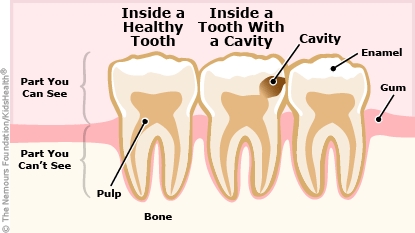- Parents Home
- Para Padres
- A to Z Dictionary
- Allergy Center
- Asthma
- Cancer
- Diabetes
- Diseases & Conditions
- Doctors & Hospitals
- Emotions & Behavior
- First Aid & Safety
- Flu (Influenza)
- Food Allergies
- General Health
- Growth & Development
- Heart Health & Conditions
- Homework Help Center
- Infections
- Newborn Care
- Nutrition & Fitness
- Play & Learn
- Pregnancy Center
- Preventing Premature Birth
- Q&A
- School & Family Life
- Sports Medicine
- Teens Home
- Para Adolescentes
- Asthma
- Be Your Best Self
- Body & Skin Care
- Cancer
- Diabetes
- Diseases & Conditions
- Drugs & Alcohol
- Flu (Influenza)
- Homework Help
- Infections
- Managing Your Weight
- Medical Care 101
- Mental Health
- Nutrition & Fitness
- Q&A
- Safety & First Aid
- School, Jobs, & Friends
- Sexual Health
- Sports Medicine
- Stress & Coping
A to Z: Dental Cavities
A dental cavity is a hole in the tooth that can grow bigger and deeper over time.
More to Know
Cavities (also called caries) happen when bacteria (germs) and food left on the teeth after eating are not brushed or flossed away. The bacteria make acid that softens the tooth's outer hard surface (called the enamel). Once this happens, the acids can cause decay deeper in the tooth. This can lead to a cavity that sometimes causes tooth pain or sensitivity.
Many kids get cavities but certain things make developing cavities more likely. These include drinking a lot of sugary drinks, using a sippy cup or bottle (filled with something other than water) throughout the day or while in bed, not getting enough fluoride, being around cigarette smoke, and taking liquid medication for a long time.

Keep in Mind
To treat a cavity, a dentist will first numb the tooth and gum area. The decayed part of the tooth is removed with a special drill, then a filling is put into the hole. Sometimes, the decay is very deep and the dentist may recommend a root canal (removing the nerve and pulp, then cleaning and sealing the inside of the tooth) or removing the tooth.
All A to Z dictionary entries are regularly reviewed by KidsHealth medical experts.

© 1995- The Nemours Foundation. KidsHealth® is a registered trademark of The Nemours Foundation. All rights reserved.
Images sourced by The Nemours Foundation and Getty Images.
